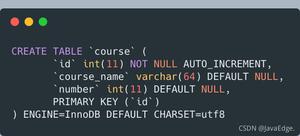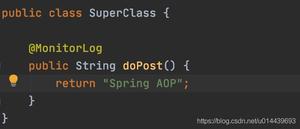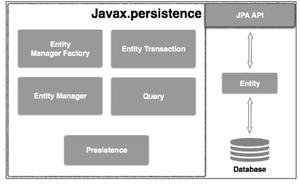Spring中集合类型属性注入
本文内容纲要:Spring中集合类型属性注入
我们都知道如何去注入普通属性的值,非常简单,那么我们如何去注入开发中常见的集合类型的属性了,别急,往下看。
这里将介绍如何给Map list set Array Properties 这些属性注入值。
1.创建一个类:员工类Employee
package cn.entity;/**
* 员工类
*
* @author hyj
*
*/
public class Employee {
//员工年龄
private Integer age;
//员工姓名
private String name;
public Employee() {
super();
// TODO Auto-generated constructor stub
}
public Employee(Integer age, String name) {
super();
this.age = age;
this.name = name;
}
public Integer getAge() {
return age;
}
public void setAge(Integer age) {
this.age = age;
}
public String getName() {
return name;
}
public void setName(String name) {
this.name = name;
}
}
2.创建第二个类里面包含上面所包含的集合和数组
package cn.collection;import java.util.List;
import java.util.Map;
import java.util.Properties;
import java.util.Set;
import cn.entity.Employee;
public class Collection {
private String [] empName;//数组
private List<Employee> empList;//list集合
private Set<Employee> empsets;//set集合
private Map<String,Employee> empMaps;//map集合
private Properties pp;//Properties的使用
public String[] getEmpName() {
return empName;
}
public void setEmpName(String[] empName) {
this.empName = empName;
}
public List<Employee> getEmpList() {
return empList;
}
public void setEmpList(List<Employee> empList) {
this.empList = empList;
}
public Set<Employee> getEmpsets() {
return empsets;
}
public void setEmpsets(Set<Employee> empsets) {
this.empsets = empsets;
}
public Map<String, Employee> getEmpMaps() {
return empMaps;
}
public void setEmpMaps(Map<String, Employee> empMaps) {
this.empMaps = empMaps;
}
public Properties getPp() {
return pp;
}
public void setPp(Properties pp) {
this.pp = pp;
}
}
3.创建ApplicationContext.xml文件
<?xml version="1.0" encoding="UTF-8"?><beans xmlns="http://www.springframework.org/schema/beans"
xmlns:xsi="http://www.w3.org/2001/XMLSchema-instance"
xsi:schemaLocation="
http://www.springframework.org/schema/beans http://www.springframework.org/schema/beans/spring-beans.xsd">
<!-- 准备员工 -->
<bean id="emp1" class="cn.entity.Employee">
<property name="age" value="18"></property>
<property name="name" value="张三"></property>
</bean>
<bean id="emp2" class="cn.entity.Employee">
<property name="age" value="18"></property>
<property name="name" value="李四"></property>
</bean>
<!-- Collection对象-->
<bean id="collection" class="cn.collection.Collection">
<!-- 给数组赋值 -->
<property name="empName">
<list>
<value>张三</value>
<value>李四</value>
<value>王五</value>
</list>
</property>
<!-- 给list集合赋值 -->
<property name="empList">
<list>
<ref bean="emp1"/>
<ref bean="emp2"/>
</list>
</property>
<!-- 给set集合赋值 -->
<property name="empsets">
<set>
<ref bean="emp1"/>
<ref bean="emp2"/>
</set>
</property>
<!-- 给Map集合赋值 -->
<property name="empMaps">
<map>
<entry key="001" value-ref="emp1"></entry>
<entry key="002" value-ref="emp2"></entry>
</map>
</property>
<!-- 给Properties集合赋值 -->
<property name="pp">
<props>
<prop key="110" >hello</prop>
<prop key="120">Spring</prop>
</props>
</property>
</bean>
</beans>
4.测试类:
package cn.test;import java.util.HashSet;
import java.util.Iterator;
import java.util.List;
import java.util.Map;
import java.util.Map.Entry;
import java.util.Set;
import org.junit.Test;
import org.springframework.context.ApplicationContext;
import org.springframework.context.support.ClassPathXmlApplicationContext;
import cn.collection.Collection;
import cn.entity.Employee;
public class TestHappy {
/**
* 给数组赋值
*/
@Test
public void setArray(){
ApplicationContext context=new ClassPathXmlApplicationContext("applicationContext.xml");
Collection collection=(Collection)context.getBean("collection");
for (String item : collection.getEmpName()) {
System.out.println(item);
}
}
/**
* 给list集合赋值
*/
@Test
public void setList(){
ApplicationContext context=new ClassPathXmlApplicationContext("applicationContext.xml");
Collection collection=(Collection)context.getBean("collection");
for (Employee item : collection.getEmpList()) {
System.out.println("年龄:"+item.getAge()+"姓名:"+item.getName());
}
}
/**
* 给set集合赋值
*/
@Test
public void setSet(){
ApplicationContext context=new ClassPathXmlApplicationContext("applicationContext.xml");
Collection collection=(Collection)context.getBean("collection");
for (Employee item : collection.getEmpsets()) {
System.out.println("年龄:"+item.getAge()+"姓名:"+item.getName());
}
}
/**
* 给map集合赋值
*/
@Test
public void setMap(){
ApplicationContext context=new ClassPathXmlApplicationContext("applicationContext.xml");
Collection collection=(Collection)context.getBean("collection");
Map<String, Employee> map=collection.getEmpMaps();
Iterator<String> iterator=map.keySet().iterator();
while (iterator.hasNext()) {
Employee employee=map.get(iterator.next());
System.out.println("年龄:"+employee.getAge()+"姓名:"+employee.getName());
}
}
@Test
/**
* Properties集合
*/
public void testSet(){
ApplicationContext context=new ClassPathXmlApplicationContext("applicationContext.xml");
Collection collection=(Collection)context.getBean("collection");
for(Entry<Object,Object> entry: collection.getPp().entrySet()){
System.out.println(entry.getKey().toString()+" "+entry.getValue().toString());
}
}
}
本文内容总结:Spring中集合类型属性注入
原文链接:https://www.cnblogs.com/hyjj/p/5945178.html
以上是 Spring中集合类型属性注入 的全部内容, 来源链接: utcz.com/z/296002.html









